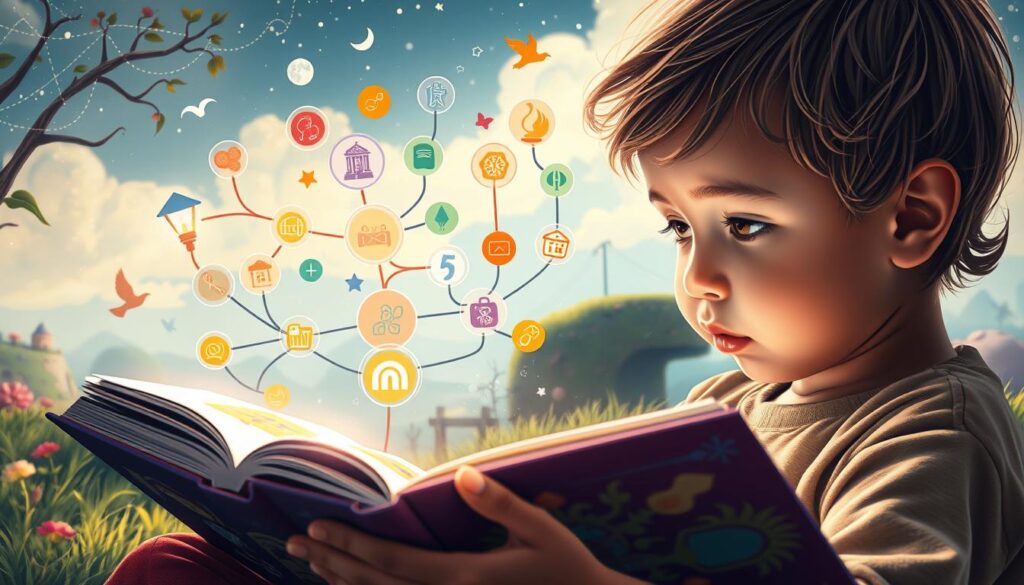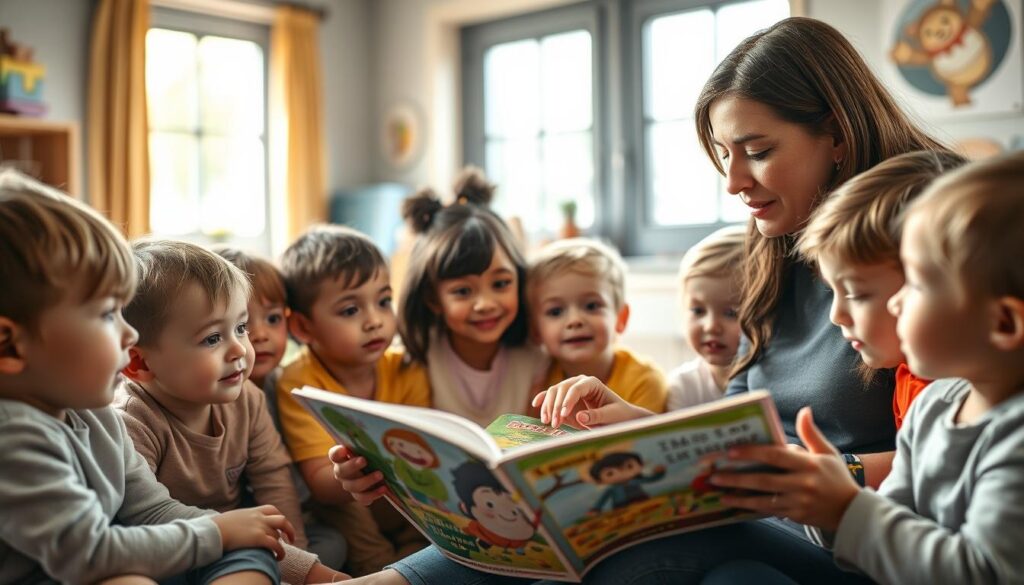Have you ever wondered how children develop the ability to understand the complex relationships between actions and their consequences? As a parent or educator, it’s essential to recognize the importance of teaching cause and effect to help children navigate the world around them.
I’m excited to share with you how engaging narratives can play a significant role in this learning process. By leveraging the power of storytelling, we can create memorable experiences that help children grasp abstract concepts in a tangible way.
As we explore this topic further, you’ll discover practical strategies and activities that you can implement right away to support your child’s cognitive development. By the end of this article, you’ll have a deeper understanding of how to harness the potential of interactive learning to foster a stronger understanding of cause and effect.
The Fundamental Connection Between Stories and Learning
Stories have long been a cornerstone of learning, captivating young minds and fostering a deep understanding of the world. As children engage with narratives, they begin to grasp complex concepts and relationships, laying the groundwork for future academic success.
By exploring stories, children develop their ability to process information in a more engaging and meaningful way. This narrative processing helps students connect abstract ideas to concrete examples, enhancing their overall comprehension.
Narrative as a Teaching Tool
Storytelling is a natural teaching tool because it leverages the human affinity for narrative. By using stories to convey cause and effect relationships, educators can make complex concepts more accessible and memorable for young learners.
For more insights on how interactive stories can enhance language learning, you can explore resources like language learning platforms.
Processing Information Through Narrative
Children process information differently when it’s presented in a narrative format versus factual data. Stories create mental frameworks that help young minds organize and make sense of new data, facilitating a deeper understanding of the world around them.
This narrative processing is crucial for developing critical thinking skills and enhancing comprehension of complex concepts.
What Are Cause and Effect Relationships?
The concept of cause and effect is fundamental to how children perceive and interact with the world around them. It’s a crucial cognitive skill that supports many other areas of development. Understanding cause and effect helps children make sense of the events happening around them, enabling them to predict outcomes and make informed decisions.
The Basics of Cause and Effect
Defining cause and effect for children involves explaining that a cause is an action or event that makes something happen, while an effect is the result of that action or event. For example, if you drop a ball (cause), it will fall to the ground (effect). This simple explanation can be built upon as children grow and develop.
- Cause: The action or event that triggers something.
- Effect: The outcome or result of the cause.
Why Understanding Cause and Effect Matters
Grasping the concept of cause and effect is essential for cognitive development as it enhances critical thinking, problem-solving, and decision-making skills. It also contributes to emotional intelligence and social skills development. By understanding that their actions have consequences, children can begin to take responsibility for their behavior and make better choices.
Research shows that understanding cause and effect is a foundational skill that supports academic learning across various subjects, from science to literature. As children progress in their educational journey, this skill becomes increasingly important for reading comprehension, scientific inquiry, and historical analysis.
The Power of Interactive Stories to Understand Cause and Effect
By engaging with interactive stories, children can develop a deeper understanding of cause and effect relationships. Interactive stories offer a unique blend of engagement and education, making complex concepts more accessible to young minds.
Interactive elements in stories enhance learning by making it more immersive and enjoyable. When children are actively involved in the storytelling process, they’re more likely to remember the lessons being taught. This is because interactivity fosters a deeper emotional connection to the story, which in turn, improves knowledge retention among students.
Enhancing Learning Through Interactivity
Interactivity in stories doesn’t just make learning fun; it also enhances the understanding of cause and effect. By allowing children to make choices and see the consequences of those choices, interactive stories teach valuable lessons about causality in a engaging and memorable way.
The Role of Engagement in Knowledge Retention
Engagement is a critical factor in learning. When children are engaged, they’re more likely to absorb and retain information. Interactive stories capitalize on this by making learning an active, rather than passive, process. As noted in a study on interactive learning, such engagement can lead to significant improvements in understanding complex concepts (source).
7 Ways Interactive Stories Teach Cause and Effect
Through interactive stories, children can explore the consequences of actions and decisions in a safe and controlled environment. This engaging approach to learning helps students develop a deeper understanding of cause and effect relationships.
1. Creating Personal Connections to Consequences
Interactive stories allow children to make personal connections to the consequences of characters’ actions, fostering a deeper understanding of cause and effect. By relating to the characters, students develop empathy and a more nuanced grasp of the effect of decisions.
2. Visualizing the Chain of Events
Interactive narratives often present a chain of events, helping children visualize how a cause leads to an effect. This visualization enhances comprehension and encourages critical thinking about the sequence of events.
3. Encouraging Critical Thinking
By presenting choices and consequences, interactive stories promote critical thinking. Children learn to analyze the cause and effect relationships, developing their problem-solving skills.
4. Building Prediction Skills
As children engage with interactive stories, they build prediction skills by anticipating the effect of characters’ actions. This skill is crucial for understanding complex cause and effect relationships and applies to various academic subjects, enhancing overall students’ skills.

Classic Interactive Books That Demonstrate Cause and Effect

The world of interactive children’s literature is rich with stories that effectively demonstrate cause and effect. These classic interactive books not only captivate young readers but also provide them with valuable lessons on the consequences of actions and choices. By engaging with these stories, children can develop a deeper understanding of how their decisions impact the world around them.
“If You Give a Mouse a Cookie” and Similar Series
Books like “If You Give a Mouse a Cookie” by Laura Numeroff are exemplary in illustrating the cause and effect relationship. The narrative follows a circular sequence of events triggered by a simple action, demonstrating how one event leads to another. This series, along with others like “The Giving Tree” by Shel Silverstein, helps children visualize the chain of events and understand the consequences of initial actions.
Choose-Your-Own-Adventure Stories
Choose-your-own-adventure stories take interactivity to the next level by allowing readers to make choices that determine the story’s outcome. This format empowers children to experiment with different decisions and see varied consequences, making the cause-effect relationship explicit and interactive. By navigating through the branching narrative structure, young readers learn that different choices lead to different outcomes, a crucial lesson for developing decision-making skills and understanding responsibility.
Some popular choose-your-own-adventure series suitable for children include “Choose Your Own Adventure” by R.A. Montgomery and “Which Way Books” by Emily James. These series not only entertain but also educate children on the importance of considering the potential effects of their actions.
Digital Interactive Stories for Today’s Tech-Savvy Kids

The digital era has brought about a new wave of interactive storytelling that captivates children and enhances their understanding of cause and effect relationships. As a parent or educator, you’re likely eager to leverage this modern approach to learning. Digital interactive stories offer a unique blend of engagement and education, making complex concepts more accessible to young minds.
These stories are not just entertaining; they’re designed to educate. By incorporating interactivity, they encourage children to participate actively in the learning process. This interactivity is key to helping kids grasp abstract concepts like cause and effect.
Apps That Teach Cause and Effect
Several apps are specifically designed to teach cause and effect through interactive stories. These apps often feature games, animations, and quizzes that make learning fun. For example, apps like “Cause and Effect” by Duck Duck Moose or “Toontastic” by Google offer engaging narratives that help children understand causality.
These apps are not only educational but also provide a safe and controlled environment for children to explore and learn. Many include features like progress tracking and adjustable difficulty levels, allowing parents to tailor the experience to their child’s needs.
Online Interactive Story Platforms
Online platforms have emerged as a valuable resource for interactive stories, offering a vast library of content that can be accessed from anywhere. Websites and services like Epic!, Storyline Online, and Reading A-Z provide a range of interactive stories that focus on cause and effect, among other educational topics.
These platforms often include additional resources such as parent guides, extension activities, and community features that enhance the learning experience. They allow children to engage with stories in a more dynamic way, reinforcing their understanding of cause and effect through repetition and varied contexts.
Using Signal Words to Identify Cause and Effect in Stories
Understanding cause and effect relationships is crucial for children’s cognitive development, and one effective way to teach this is by using signal words in stories. Signal words are specific words or phrases that indicate a cause-and-effect relationship between events or actions in a narrative. By teaching children to identify these words, we can enhance their comprehension and analytical skills.
When children learn to recognize signal words, they become better at understanding the structure of stories and can more easily follow the plot. This skill is not only beneficial for reading comprehension but also for developing critical thinking skills.
Causes Indicated by Key Words
Certain words and phrases signal causes in stories, such as “because,” “since,” and “as a result of.” When children encounter these words, they should learn to identify the cause that precedes the effect. For example, in the sentence “She was late because it was raining,” “because it was raining” is the cause.
To help children practice identifying causes, you can use interactive stories that incorporate these signal words. For instance, you can read a story together and pause to ask, “What caused this event to happen?”
- because
- since
- as a result of
- due to
Words That Signal Effects
Just as there are words that signal causes, there are also words that indicate effects, such as “therefore,” “consequently,” and “as a result.” These words help children understand that what follows is a consequence of a previous action or event. For example, “The rain was heavy; therefore, the park was empty.”
| Signal Word/Phrase | Example Sentence |
|---|---|
| therefore | The rain was heavy; therefore, the park was empty. |
| consequently | She didn’t study; consequently, she failed the test. |
| as a result | He worked hard; as a result, he achieved his goals. |
Creating Graphic Organizers for Visual Learners
Graphic organizers are a powerful tool for helping kids visualize the complex relationships between causes and effects. By using these visual aids, children can better understand how events are interconnected.
For young children, simple flow charts can be particularly effective. These charts help kids identify the cause and effect sequence in a straightforward manner, making it easier for them to grasp this fundamental concept.
Simple Flow Charts for Young Children
Simple flow charts are an excellent starting point. They typically involve a series of boxes or circles connected by arrows, illustrating the sequence of events. For example, you can create a flow chart that shows what happens when it rains, starting with the rain, then the effect of flooding, and finally the consequences of the flood.
More Complex Organizers for Older Kids
As children grow older, they can benefit from more complex graphic organizers. These might include Venn diagrams to compare multiple causes or effects, or fishbone diagrams to identify various contributing factors. Such tools help older kids analyze complex narratives and real-life situations more effectively.
| Type of Organizer | Description | Age Group |
|---|---|---|
| Simple Flow Chart | Illustrates a straightforward cause-effect sequence | Young Children |
| Venn Diagram | Compares multiple causes or effects | Older Kids |
| Fishbone Diagram | Identifies various contributing factors | Older Kids |
By introducing these graphic organizers, you can help kids develop a deeper understanding of cause and effect relationships, enhancing their critical thinking skills and analytical abilities.
Role-Playing and Acting Out Interactive Stories
Role-playing is a powerful tool for helping children grasp the concept of cause and effect in interactive stories. By acting out stories, children can explore the consequences of different actions in a safe and controlled environment. This hands-on approach not only makes learning fun but also enhances understanding and retention.
How Embodied Learning Reinforces Concepts
Embodied learning, which involves physical movement and activity, can significantly reinforce the understanding of cause and effect. When children act out a story, they physically experience the cause-and-effect relationships, making these concepts more tangible and memorable. For instance, if a character in a story plants a seed and it grows into a flower, children can mimic the actions of planting and nurturing, thereby internalizing the process.
Setting Up Story-Based Role Play Activities
To set up effective role-play activities, start by selecting stories that clearly illustrate cause and effect relationships. You can then create simple props and settings that enhance the learning experience. For example, if the story involves a character going on a picnic, you can set up a pretend picnic area with toy food and baskets. Encourage children to take turns acting out different parts of the story, and guide them with open-ended questions to explore the cause-and-effect connections. By doing so, you’ll help children develop a deeper understanding of how their actions can lead to various outcomes.
Real-Life Examples to Connect With Interactive Stories
Helping children see the connection between the stories they read and their own experiences is crucial for reinforcing their understanding of cause and effect. When children can relate to the scenarios presented in interactive stories, they’re more likely to grasp the lessons being taught.
Everyday Cause and Effect Scenarios
To make the concept of cause and effect more tangible, it’s helpful to point out everyday scenarios that demonstrate this relationship. For example, you can explain how leaving a toy outside on a rainy day (cause) might result in it getting wet (effect). By highlighting such scenarios, you help children understand that cause and effect are not limited to stories but are present in their daily lives.

Linking Story Lessons to Children’s Experiences
To further reinforce the lessons from interactive stories, ask questions that prompt children to reflect on similar experiences they’ve had. For instance, you might say, “Remember when you accidentally knocked over a glass of water? What happened next?” Such conversations help children develop self-awareness about their actions and their consequences. You can also use this opportunity to discuss how the story lessons can be applied to future situations, making the learning more meaningful and memorable.
| Story Lesson | Real-Life Connection | Discussion Points |
|---|---|---|
| A character’s actions lead to an unexpected outcome. | Accidentally breaking a toy while playing roughly. | How did the character feel? How did you feel when you broke the toy? |
| A decision made by a character results in a positive consequence. | Sharing a toy with a friend and feeling happy. | What was the character’s decision? How did it make them feel? |
| A character learns a lesson from their mistake. | Touching a hot stove and learning to be cautious. | What did the character learn? What did you learn from a similar experience? |
By making these connections, you’re not only teaching children about cause and effect but also helping them develop critical thinking skills and a deeper understanding of their own experiences. For more interactive storytelling ideas, you can explore platforms like Lunesia’s interactive storytelling section.
Age-Appropriate Interactive Stories for Different Developmental Stages
Interactive stories can be a powerful tool for teaching cause and effect, but their effectiveness depends on being tailored to the child’s age and developmental stage. As children grow, their ability to understand complex relationships between events evolves. Choosing stories that match their developmental stage is crucial for maximizing their learning potential.
For children to benefit from interactive stories, it’s essential to consider their age and developmental stage. This ensures that the content is neither too simple nor too complex, keeping the child engaged and challenged appropriately.
Preschool (Ages 3-5)
For preschoolers, simple, visual stories with clear cause-and-effect relationships work best. Interactive elements like “what happens next?” encourage children to think about consequences. Stories with repetitive actions and outcomes, like “If You Give a Mouse a Cookie,” are ideal for this age group.
Early Elementary (Ages 6-8)
Children in early elementary school can understand more complex stories with multiple cause-and-effect relationships. Interactive stories that ask children to predict outcomes or choose what happens next can enhance their critical thinking skills. Stories that present relatable scenarios help them connect actions to consequences.
Upper Elementary (Ages 9-12)
For upper elementary children, interactive stories can explore more abstract concepts and multi-step cause-and-effect relationships. Stories that present ethical dilemmas or historical scenarios encourage critical thinking and analysis. These stories can help children understand systemic causes and effects, as well as long-term consequences.
Creating Your Own Interactive Cause and Effect Stories
You can foster a deeper understanding of cause and effect in children by creating your own interactive stories together. This collaborative process not only enhances their comprehension of the concept but also encourages creativity and critical thinking.
To get started, you can use simple templates that outline a story with cause and effect scenarios. For instance, you can create a story where a character’s action leads to a consequence, and then ask children to predict or decide what happens next.
Simple Templates to Get Started
Using templates can simplify the story creation process. You can begin with a basic structure that includes:
- A main character
- An action or decision made by the character
- The effect or consequence of that action
Here’s an example template:
| Character’s Action | Cause | Effect |
|---|---|---|
| Forgot umbrella | It started raining | Got wet |
| Studied hard | Prepared well for the exam | Achieved good grades |
By filling out such templates, children can visualize the cause and effect relationships and develop their narrative skills.
Involving Children in the Creation Process
Involving children in the creation of interactive stories deepens their understanding of cause and effect. By contributing to different aspects of story creation, such as character development, plot twists, and outcomes, children articulate their understanding of how actions lead to consequences.
To guide this process without taking over creative control, ask open-ended questions that prompt children to think about logical cause-effect relationships. For example, “What might happen if the character decides to…”, or “How do you think the character will react to…”.
“The art of storytelling is the art of revealing the human experience.” –
This creative process not only teaches cause and effect but also helps children develop their narrative skills. As you engage in creating interactive stories together, you’ll notice how it enhances their ability to think critically and make informed decisions.
For more interactive stories and resources, you can explore platforms like Lunesia’s Interactive Stories, which offer a variety of engaging content for children.
How Understanding Cause and Effect Through Stories Transfers to Academic Success
Understanding cause and effect through interactive stories is a foundational skill that significantly influences a child’s academic trajectory. By grasping these relationships, children develop critical thinking skills that benefit various aspects of their academic journey.
Reading Comprehension Benefits
Comprehending cause and effect enhances reading comprehension by allowing children to understand the underlying reasons for events in a story. This skill helps them analyze plots more effectively and predict outcomes.
Science and History Learning Advantages
In subjects like science and history, understanding cause and effect is crucial. It enables children to grasp complex phenomena, such as historical events or scientific processes, by recognizing the causes and effects involved.
Problem-Solving Skill Development
The ability to analyze cause and effect relationships fosters effective problem-solving skills. Children learn to identify problems, anticipate potential outcomes of their actions, and make informed decisions.
| Academic Area | Benefits of Understanding Cause and Effect |
|---|---|
| Reading Comprehension | Enhanced plot analysis and prediction skills |
| Science and History | Better understanding of complex phenomena and events |
| Problem-Solving | Improved ability to analyze problems and anticipate outcomes |
By developing an understanding of cause and effect through interactive stories, children build a strong foundation for academic success across various subjects and skills.
Beyond Academic Skills: Life Lessons from Interactive Stories
Interactive stories are not just a tool for learning; they’re a gateway to developing essential life skills in children. As we explore the benefits of these stories, it becomes clear that their impact extends far beyond the classroom.
Developing Empathy and Emotional Intelligence
Through interactive stories, children can develop a deeper understanding of others’ feelings and perspectives. By engaging with characters and their experiences, kids learn to empathize and manage their own emotions more effectively. This emotional intelligence is crucial for building strong relationships and achieving personal well-being.
Preparing Children for Real-World Decision Making
Interactive stories provide a safe environment for children to practice decision making and understand the cause and effect of their choices. By exploring different scenarios and outcomes, kids develop critical thinking skills and learn to make informed decisions. This skill is essential for navigating the complexities of real life, where understanding the potential effect of one’s actions is vital.
Conclusion
As we wrap up our exploration of interactive stories, it’s clear that these engaging tools play a vital role in teaching children about cause and effect. Through interactive stories, kids can develop a deeper understanding of how their actions have consequences, a crucial life skill that supports cognitive development and academic success.
The engaging nature of interactive stories makes learning this concept enjoyable and effective. By leveraging practical strategies and resources, parents and educators can make cause and effect a regular part of children’s learning experiences, empowering them to become thoughtful and responsible individuals.
FAQ
How can I help my child develop a deeper understanding of cause and effect relationships?
You can help your child by reading interactive stories together and discussing the consequences of characters’ actions. This develops their critical thinking skills and enhances their ability to predict outcomes.
What are some effective ways to teach cause and effect to preschoolers?
Using simple, visual examples like “If You Give a Mouse a Cookie” can help young children grasp the concept. You can also use everyday scenarios, like spilling water, to demonstrate cause and effect.
How can I encourage my child to think critically about the consequences of their actions?
Engage your child in role-playing activities based on stories, and ask open-ended questions about the characters’ decisions and their outcomes. This helps develop their problem-solving skills and emotional intelligence.
Are there any digital tools or apps that can help teach cause and effect relationships?
Yes, there are several educational apps and online platforms that offer interactive stories and activities designed to teach cause and effect. These can be a fun and engaging way to supplement traditional teaching methods.
How can I assess my child’s understanding of cause and effect concepts?
You can assess their understanding by asking them to predict outcomes in stories or real-life scenarios, or by having them create their own simple cause and effect stories or diagrams.
What are some age-appropriate ways to introduce cause and effect to children?
For younger children, use simple stories and visual aids. For older children, you can use more complex stories and encourage them to create their own cause and effect scenarios or graphic organizers.




